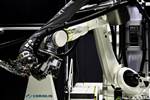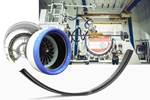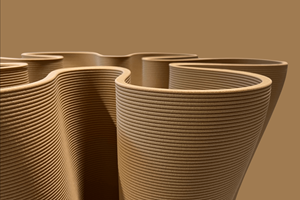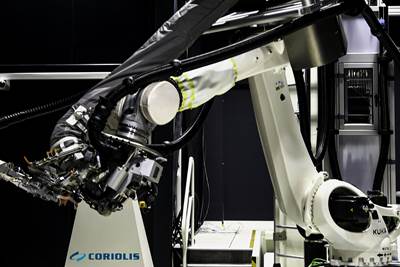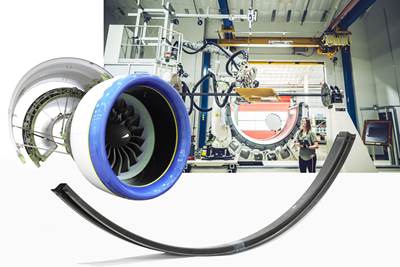Coriolis highlights C1.2 compact AFP system for multi-material applications
New developments regarding productivity, maintenance and ergonomics make this enhanced composite placement system well suited for the production of complex parts.
The C1.2 AFP system. Photo Credit, all images: Coriolis Composites
Coriolis Composites (Quéven, France) has been providing the C1.2, a compact, easy-to-use and versatile machine for depositing multi-materials (thermosets, thermoplastics and dry fiber), since the end of 2022. The result of long observation and experience based on nearly 80 Coriolis C1 machines in operation globally since 2010, the C1.2 automated fiber placement (AFP) system is available in two options: able to place 8 or 16 tapes/tows (¼-inch-wide).
The C1.2 features optimized head compactness, increased productivity and reliability, improved maintainability and a focus on its footprint and sustainability, further detailed below.
C1.2 8 fibers version used for a 1-meter-diameter concave mold (left) and 45° chamfers (right).
The C1.2 maintains the compactness of its predecessor, which has made C1 machines successful for complex parts. For example, the C1.2 can fit into 1-meter-diameter concave tooling. According to Coriolis, the C1.2 8 fibers version is even more compact so it can address 45° ramps. The compactness of the 16 fibers version has also been optimized.
Maintenance for routine operations on the head can now be carried out without tools. The duct support frame (which holds the guide duct) has been lowered for easier management. Duct balancers are accessible directly from the ground. The in-line Multiwinch reduces fiber tension for snag-free passage in the guide duct. Each cutting blade can also achieve up to 100,000 cuts, which significantly reduces blade changes.
C1.2 in laser configuration and online inspection in R750-mm concave mold.
One of the more major developments is the C1.2’s ability to achieve higher layup speeds — up to 1 m/s when feeding and cutting, and more than 1.5 m/s during layup — with improved reliability. This gain in speed is explained by the use of motorized modules in the creel accommodating fiber spool up to 15 kg of raw material, i.e. three times more material on board combined with controlled management of the dancing arms, which improve the unwinding of the material. Three infrared lamps are supplied as standard for additional speed. Additional time savings are achieved via link paths in the case of alternating layups, mainly for 0º plies. The equipment also makes it possible to obtain cleaner, straighter fiber cuts, even at high speeds, and better feeding. The C1.2 can also use very thick materials, further enhancing productivity.
To evaluate overall C1.2 process reliability, Coriolis performed a mean strip before failure (MSBF) test at high velocity. This performance and reliability test was done with more than 30,000 cuts per blade through 144 small panels (18 mm thick) made of feeds and cuts separated by 2-mm gaps. The 8 fibers machine resulted in an MSBF value of 15,000.
Finally, the AFP robot has been better integrated into the rail, and the creel can be accessed without a platform, thus reducing the footprint of the AFP enclosure, and improving overall cell ergonomics. Compaction pressure is now an advantage for reducing porosity during the in-situ deposition of thermoplastics. To address current environmental challenges, the process remains light and energy efficient compared to more massive and heavy solutions. The C1.2 is also compatible with in-line inspection solutions (AIS) developed by Coriolis and is suitable for mounting compact laser optics.
The C1.2 is a versatile machine for multi-material applications in R&D. Coriolis also has a range of machines with interchangeable heads for larger and less complex parts, including the Coriolis C3 and C5.
Related Content
Sulapac introduces Sulapac Flow 1.7 to replace PLA, ABS and PP in FDM, FGF
Available as filament and granules for extrusion, new wood composite matches properties yet is compostable, eliminates microplastics and reduces carbon footprint.
Read MoreIndustrializing additive manufacturing in the defense/aerospace sector
GA-ASI demonstrates a path forward for the use of additive technologies for composite tooling, flight-qualified parts.
Read MoreCarbon fiber composite pallet revolutionizes freight industry
LOG Point Pallet fuses advanced materials with innovative design and manufacturing to improve supply chains worldwide.
Read MoreCombining multifunctional thermoplastic composites, additive manufacturing for next-gen airframe structures
The DOMMINIO project combines AFP with 3D printed gyroid cores, embedded SHM sensors and smart materials for induction-driven disassembly of parts at end of life.
Read MoreRead Next
Coriolis Composites installs AFP machine at Sabanci University
C1 robot contributes to technology development at the Integrated Manufacturing Technologies Research and Application Center (SU IMC) in Istanbul.
Read MoreThe potential for thermoplastic composite nacelles
Collins Aerospace draws on global team, decades of experience to demonstrate large, curved AFP and welded structures for the next generation of aircraft.
Read MoreScaling up, optimizing the flax fiber composite camper
Greenlander’s Sherpa RV cab, which is largely constructed from flax fiber/bio-epoxy sandwich panels, nears commercial production readiness and next-generation scale-up.
Read More
